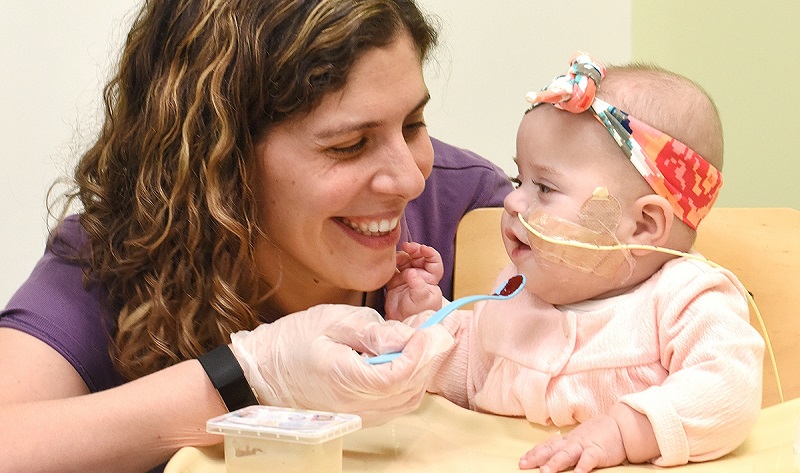Feeding Therapy Farmingdale NY: Supporting Healthy Eating
Wiki Article
Browsing the Path to Effective Feeding: Ingenious Strategies and Interventions for Effective Feeding Treatment
Are you having a hard time to discover efficient approaches and interventions for effective feeding therapy? Look no even more. This article will lead you through the path to success, supplying ingenious techniques to evaluate feeding challenges and set possible goals. With evidence-based methods, you'll find out how to deal with sensory processing concerns and use assistive innovation and flexible tools. And also, we'll show you the importance of working together with households and caregivers for optimal feeding results. Prepare to navigate the path to successful feeding!Assessing Feeding Difficulties and Identifying Goals
You need to start by assessing your child's feeding difficulties and recognizing particular objectives for their treatment. This step is vital in creating an effective feeding treatment strategy. Begin by observing your child's feeding behaviors and patterns. Look for any type of aversions or problems they might have in the direction of specific foods or textures. Keep in mind of any physical or sensory problems that might be impacting their ability to eat. When you have recognized these obstacles, you can after that establish certain objectives for their therapy. These objectives must be obtainable and practical, concentrating on improving your kid's feeding abilities and general nutrition. You may establish an objective for your kid to be able to tolerate a larger range of appearances or to self-feed with tools. It is very important to connect these goals with your kid's feeding specialist so they can customize the therapy sessions to resolve these particular obstacles. By examining your youngster's feeding difficulties and establishing objectives, you are taking the very first step towards aiding them develop successful feeding skills.Carrying Out Evidence-Based Strategies for Feeding Therapy
Applying evidence-based strategies for feeding treatment can result in positive results for children. You are making certain that the interventions used are sustained by scientific research study and have been proven effective when you incorporate these methods right into your youngster's therapy strategy. This strategy raises the likelihood of success and assists address the particular feeding difficulties your youngster may be experiencing.By complying with evidence-based strategies, you can offer your kid with the finest possible treatment and assistance. These methods may include using a selection of sensory experiences throughout mealtimes, such as exploring various textures and tastes, to motivate acceptance of new foods. Additionally, executing therapy techniques can aid resolve fussy consuming habits and promote healthier consuming patterns.
One more essential facet of evidence-based feeding therapy is involving the family members in the treatment procedure. By providing education and learning and assistance to caretakers and moms and dads, they can play an energetic function in aiding their kid get over feeding challenges. This joint approach improves the efficiency of therapy and advertises enduring positive modifications in your youngster's eating routines.

Addressing Sensory Processing Issues in Feeding Therapy
Dealing with sensory processing problems in feeding therapy can be challenging, but it is necessary for advertising a favorable eating experience for children. When you experience a kid with sensory processing problems throughout nourishment, it is necessary to recognize that their reactions to particular textures, tastes, scents, and even audios are not intentional (feeding therapy long island). By acknowledging and attending to these issues, you can help develop a helpful environment that urges healthy and balanced consuming behaviors
One effective strategy is to present brand-new foods progressively. Begin with little, non-threatening portions and gradually raise the quantity gradually. This technique enables the child to become aware of the food and its sensory residential or commercial properties at their own speed. Additionally, offering a selection of structures and flavors can help desensitize their sensory system and increase their food choices.
Involving the child in sensory play tasks can likewise be beneficial. Encourage them to discover various appearances, such as squishing, squeezing, or touching numerous food products. This can help normalize sensory input and decrease hostilities to certain appearances.
One more crucial element is offering a organized and calm eating environment. Minimize diversions, such as loud sounds or brilliant lights, which can overwhelm their senses and impede their capability to concentrate on consuming. Developing a predictable routine and making use of visual routines can also assist the youngster really feel more secure and in control during nourishment.

Making Use Of Assistive Technology and Adaptive Equipment
Making use of assistive innovation and adaptive devices can considerably boost the feeding experience for youngsters with sensory processing difficulties. Nourishment can be frustrating and difficult when you have trouble with sensory processing. But with the right tools, you can make it a more satisfying and effective experience.One alternative is making use of specialized utensils and plates developed to suit your requirements. These tools might have textured takes care of or a larger get redirected here grasp, making them less complicated to manipulate and hold. Plates with split sections can assist separate various foods and stop them from touching, which can be a resource of pain for some kids.
In enhancement to specialized plates and utensils, there are also assistive tools that can be used throughout feeding. As an example, a weighted vest or lap pad can give deep stress input, aiding to relax and manage your sensory system. A vibrating tooth brush or chewable fashion jewelry can provide dental sensory excitement, making the act of consuming much more enjoyable.
Modern technology can additionally play a duty in boosting the feeding experience. There are apps and devices readily available that can supply acoustic or visual hints, such as timers or prompts, to assist you stay concentrated and arranged during mealtime.
Working Together With Families and Caretakers for Successful Feeding Results
When working together with family members and caretakers, you can work together to develop a supportive and caring environment for effective More hints feeding outcomes. By entailing families and caretakers in the feeding treatment process, you can acquire valuable understandings into the child's feeding preferences, practices, and challenges. food therapist farmingdale. This collaboration enables an all natural approach to feeding therapy, dealing with not just the physical aspects however also the mental and emotional aspects that may affect a youngster's feeding abilitiesOne secret facet of working together with caretakers and households is offering education and learning and training. By equipping them with understanding and skills, they can proactively join the feeding treatment process and sustain the youngster's progress outside of therapy sessions. This can include instructing them feeding methods, strategies for handling mealtime actions, and recognizing the significance of consistency and regimen in establishing healthy consuming practices.
In addition, involving family members and caregivers in objective setup and treatment preparation guarantees that their point of views and goals for the child are taken right into factor to consider. By working together, you can establish reasonable and possible objectives that line up with the household's priorities and worths - feeding therapy farmingdale ny. This collective technique promotes a feeling of ownership and empowerment, producing a strong foundation for successful feeding outcomes
Additionally, regular and open interaction with households and caretakers is crucial for effective collaboration. By keeping continuous discussion, you can deal with concerns, give assistance, and make needed changes to the feeding treatment strategy as needed. This interaction likewise enables sharing progression updates, celebrating achievements, and identifying any type of difficulties or obstacles that may arise.

Final Thought
Congratulations on finishing this article on navigating the course to successful feeding! You have actually checked out various methods and treatments for effective feeding treatment, such as assessing challenges, applying evidence-based methods, attending to sensory processing concerns, and making use of assistive modern technology. By teaming up with caregivers and families, you can make sure effective feeding end results. Bear in mind to constantly remain proactive and ingenious in your technique to feeding treatment. Maintain the great job!It's vital to interact these objectives with your child's feeding specialist so they can customize the therapy sessions to resolve these specific difficulties.Implementing evidence-based strategies for feeding treatment can lead to positive end results for youngsters.Dealing with sensory processing problems in feeding therapy can be challenging, however it is important for my company promoting a favorable eating experience for children. By entailing family members and caregivers in the feeding therapy procedure, you can acquire important insights into the child's feeding preferences, difficulties, and routines. By furnishing them with knowledge and skills, they can proactively participate in the feeding therapy procedure and sustain the child's development outside of treatment sessions.
Report this wiki page